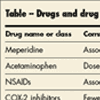- Clinical Technology
- Adult Immunization
- Hepatology
- Pediatric Immunization
- Screening
- Psychiatry
- Allergy
- Women's Health
- Cardiology
- Pediatrics
- Dermatology
- Endocrinology
- Pain Management
- Gastroenterology
- Infectious Disease
- Obesity Medicine
- Rheumatology
- Nephrology
- Neurology
- Pulmonology
Optimal Strategies for Pain Control in Elderly Patients
ain management is a commonand challenging aspect of caringfor elderly patients. The principlesthat guide therapeutic pain managementin these persons are differentfrom those used in the treatmentof younger persons.
CASE 1:
A 20-year-old woman sustainsa fracture of the rightfemur during a car accident. She is taken byambulance to the emergency department(ED). On arrival in the ED, she is given intravenousmeperidine, which significantly relievesher pain. The patient subsequently undergoessurgical repair of the fractured femur and isdischarged to rehabilitation after an uneventfulhospital stay.
CASE 2:
A 75-year-old womansustains a fracture of theright femur during a car accident. She is takenby ambulance to the ED. She has no significantmedical history and is otherwise healthy.On arrival in the ED, she is given intravenousmeperidine, which initially relieves her pain.After transfer to the medical-surgical floor, thepatient experiences tremulousness, dysphoria,and myoclonus. Subsequently, she has aseizure.
The injury and its treatment were identical in both cases.What went wrong in Case 2?
Meperidine has a half-life of approximately3 hours; however, itsmetabolite--normeperidine--has a6-hour half-life. Because renal insufficiencyis highly prevalent amongelderly persons, accumulation of normeperidineis common, and undesirableside effects may ensue.
1
Thetremulousness, dysphoria, myoclonus,and seizure observed in theelderly woman in Case 2 result fromelevated blood levels of normeperidine
(Table).

TableMeperidine is also associatedwith an increased risk of falls.
2
Theseadverse effects are much less commonin younger adults because normalrenal function generally allowsfor clearance of the metabolite fromthe bloodstream.Meperidine can cause deliriumin elderly patients. In a seminalstudy on this topic, delirium was significantlyassociated with meperidineadministration in postsurgical patients(mean age, 73 +/-8 years).
3
Pain management is a commonand challenging aspect of caringfor elderly patients. The principlesthat guide therapeutic pain managementin these persons are differentfrom those used in the treatmentof younger persons. Dosing usuallyrequires careful titration with frequentassessment and dosage adjustments.Inadequate managementof perioperative pain in elderly personsmay be associated with delaysin rehabilitation, increased lengthof hospital stay, and increasedcomorbidity.
2
PHARMACOLOGICINTERVENTION

Figure
A 3-step approach.
The WorldHealth Organization (WHO) has developeda validated 3-step "analgesicladder"
(Figure).
1
Although it wasoriginally intended as a guide for reliefof cancer pain, this algorithm isalso helpful in the management ofother types of pain.Agents for
mild pain
(step 1)include acetaminophen and NSAIDs.Acetaminophen is relatively safein elderly persons and is as effectiveas NSAIDs.
2,4
The maximum dailydose should not exceed 4 g; higherdoses do not provide additional paincontrol and they increase the risk ofside effects.
2
The choice of appropriate adjuvanttherapy depends on the cause ofpain. For example, if an element ofneuropathic pain is present, the patientmay benefit from the addition ofan anticonvulsant.
1
Associated fearand anxiety should also be managedappropriately.NSAIDs provide good analgesiabut are associated with a number ofside effects in elderly persons; theseinclude gastropathy, renal failure,inhibition of platelet aggregation, andCNS changes.
1
For these reasons,NSAIDs are a suboptimal choice,even as short-term therapy for inflammatoryarthritic conditions.The usefulness of COX-2 selectiveinhibitors in elderly persons isunclear.
1
Although there may befewer GI effects, these agents are associatedwith renal dysfunction.If step 1 medications do not provideadequate relief, consider agentsfor
moderate and severe pain
(steps2 and 3), which include opioids otherthan meperidine. Continue the nonnarcotic,and add a mild opioid to theregimen. If pain persists, advance to astronger opioid, then reassess. Continueto reassess to determine the effectivenessof therapy.
Tips on prescribing opioids.
Short-term research studies suggestthat elderly persons are more sensitiveto the analgesic impact of opioidsthan younger persons; therefore, uselow doses initially and increase asneeded.
4
Opioids are available inshort-acting and extended-release formulations.Consider renal functionwhen determining dose and frequencyof these agents.Side effects of opioids includeconstipation, nausea, vomiting,sedation, delirium, and respiratorydepression. Tolerance of nauseaand vomiting may develop over a periodof days; prescribe additionalmedication, as needed, to temporarilyrelieve these symptoms.
2
Toleranceof constipation is not likely todevelop, however, and this sideeffect is best treated prophylacticallyand continually.
2
True addiction is rare among patientswho are taking appropriatedosages of opioids for medical reasons.However, "pseudoaddiction"may occur when pain is undertreated;it resolves with adequate pain management.
1
Fear of causing addictionshould not be a deterrent to opioiduse in pain management.In addition to standing painmedication orders, a pain managementregimen should include ordersfor as-needed pain medications to address "breakthrough" pain. A patientmay be started with a short-actingopioid initially while the proper dosefor pain control is determined. Thepatient can then be switched to along-acting formulation, with shortactingmedication available for breakthroughpain.
2
Assessing pain control.
Askthe patient how much pain he or sheis experiencing on a scale of 0 to 10(0 denotes no pain and 10 the worstpain imaginable). Ask this questionbefore and after administration ofpain medication so you can assessrelative improvement. However, painscales may be too complicated for elderlypatients with impaired cognition.A patient's inability to discusspain does not obviate the need forpain assessment. In conditions inwhich pain is expected, such as hipfracture, be alert for signs of discomfort,including behavioral disturbancesor agitation in a severely dementedpatient.
NONPHARMACOLOGICINTERVENTION
Nonpharmacologic measuresinclude such modalities as exercise,physical or occupational therapy, andcognitive-behavioral therapy. Theyare effective when used in conjunctionwith medication in the managementof all forms of pain.
2
Specific examplesinclude:
- Physical and occupational therapies,which are useful in treating musculoskeletalpain.
- External temperature modulation:application of cold can reduce productionof by-products of tissue damage;warmth induces production of endogenousopioids.
- Transcutaneous electrical nervestimulation, percutaneous nerve stimulation,and acupuncture, which alsomay stimulate the release of endogenousopioids.
- Relaxation techniques, which candecrease anxiety, thus relieving pain.
Patient education is vital.
1
It providesrealistic expectations for painmanagement and makes patientsaware of benefits and risks of bothpharmacologic and nonpharmacologicpain management strategies. It fosterspatient autonomy and is likely toresult in better pain control.
